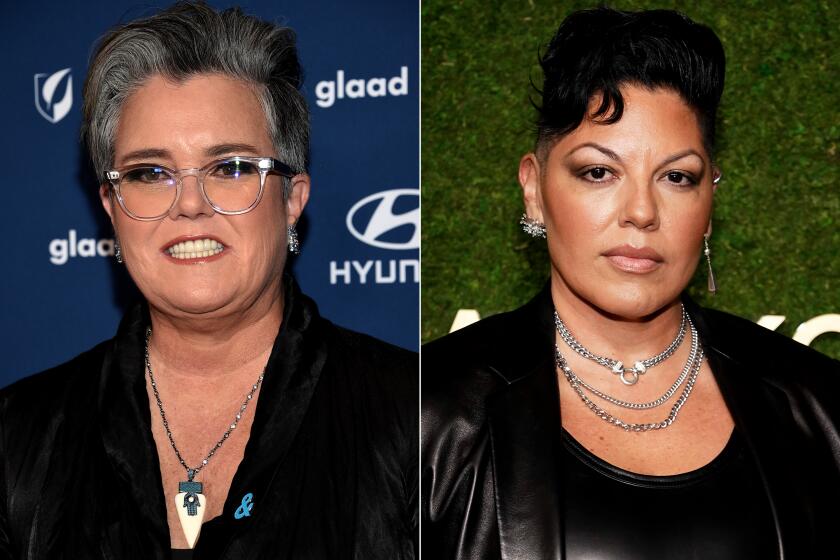‘Orange Is the New Black’ underscored Netflix’s disruptive potential
When “Orange Is the New Black” debuted on Netflix in July 2013, it felt like an afterthought.
A few months earlier, “House of Cards” had rolled out to great fanfare. The streaming network had reportedly paid $100 million for two seasons of the political drama, executive produced by David Fincher and starring two-time Oscar winner Kevin Spacey. It was followed by a highly anticipated revival of the cult sitcom “Arrested Development.”
By contrast, “Orange Is the New Black” boasted no major stars, no Oscar winners and a relatively modest budget. Several prestigious cable networks had already passed on the series, which was adapted by “Weeds” creator Jenji Kohan from Piper Kerman’s memoir about her time in a women’s prison. Arguably the biggest names in the cast were Natasha Lyonne, a former teen star who’d battled drug addiction, and Laura Prepon, who played the girl next door in the long-running sitcom “That ’70s Show.”
In what was then a novelty, all 13 episodes were available for viewers to watch at any time. But with its grim setting, challenging subject matter and hourlong format, “Orange Is the New Black” hardly seemed the kind of escapist fare viewers would consume in giddy binge-watching sessions.
Yet “Orange” would end the year as Netflix’s most-watched original, and it received 12 Emmy nominations for its first season — instantly establishing the streaming network as an awards powerhouse.
“We were definitely in the shadow of ‘House of Cards,’” Kohan recalled recently by phone. “We were the little engine that could. But I like that. There’s less pressure. It’s better to be a surprise than a disappointment.”
The series also resonated in a way that went beyond industry bragging rights, helping push criminal justice reform and transgender rights to the forefront of the national conversation. Through flashbacks that showed how each character wound up in prison, “Orange” encouraged viewers to identify with a vast array of characters whose race, religion, class, politics or gender identity often differed from their own.
Each new season rolled out in June or July — once a relatively quiet period in the TV year — fueling midsummer binge-watching and driving social media chatter. With its seventh and final season launching Friday, “Orange Is the New Black” remains the most-watched original on Netflix, according to the service. It was also named viewers’ favorite show on Netflix, according to a recent poll by the research firm MoffettNathanson.
“Orange” was neither Netflix’s splashiest original series nor its most prestigious, but it became the model for new kind of hit in the streaming era: a show with little star power that debuted quietly but grew into a phenomenon, fueled by social media, the mysterious Netflix algorithm and good old-fashioned word-of-mouth.
It’s a pattern that has been followed by virtually every series to break out on Netflix since, most notably “Stranger Things,” which came out of nowhere in 2016, became a pop culture sensation, revived Winona Ryder’s career and made its adolescent cast into celebrities. “BoJack Horseman,” “The Crown, “Dead to Me” and “GLOW” have all followed similar, if less meteoric, trajectories. Perhaps following Netflix’s example, broadcast networks that seven or eight years ago canceled struggling series after a handful of episodes now show greater patience. (Netflix, more powerful than ever, appears to be moving in the opposite direction: Its recent cancellation spree, which has included “She’s Gotta Have It” and “One Day at a Time,” continued Wednesday with the news that the platform had declined to renew animated series “Tuca & Bertie” for a second season.)
As industry delight over recent losses proves, Netflix has gone from the new kid on the block to the company everyone loves to hate.
When Kohan brought her idea for a show set in a women’s prison to Netflix, she didn’t care that the streaming service was known as the place you’d go to catch up on old seasons of “Breaking Bad” and not as a destination for original content. Netflix was willing to forgo the traditional pilot model and order an entire season at once. “It was radical to our ears,” Kohan said.
The showrunner wasn’t quite as sold on the binge-watching model — and she still has mixed feelings.
“It’s wonderful to have instant gratification, and get what you want when you want it, and be able to click on the next one and consume it in a different way, where it really soaks in. But I really do miss having people on the same page at the same time and be able to discuss what’s happening in the show in real time. Look, the model has been very good to us. But I do miss that social aspect.”
Despite her ambivalence, Kohan and executive producer Tara Herrmann say the fact that all episodes were available to watch back-to-back allowed them to take their time with the storytelling, knowing that a week hadn’t passed between episodes, but more likely an hour or a day — meaning that viewers wouldn’t need to be reintroduced to characters or plot lines.
The model — here are the episodes; watch ’em when you want — also enabled “Orange” to build a wide audience without the pressure of capturing a specific demographic during a designated time slot on a linear network.
Based on anecdotal evidence, “Orange” did just that, defying industry assumptions about the “risk” of a TV show focused largely on the experiences of poor women of color.
“We introduced audiences to characters they never would have seen otherwise and probably had judgments on,” Hermann said.
“I hope our legacy is empathy,” Kohan added. “There’s a definite dearth of that these days.”

In the bubble of the writers room, the producers say they were less aware of the show’s impact. But its stars, many of them complete unknowns before the series debuted, were acutely aware of how it reverberated across the culture.
Uzo Aduba had worked only in theater when she was cast as Suzanne “Crazy Eyes” Warren, an inmate who takes a shine to series protagonist Piper Chapman (Taylor Schilling). She is now a two-time Emmy winner.
She vividly remembers how her social media following surged as soon as “Orange” debuted in 2013 and continued to do so when the show came back each summer. The series’ popularity truly sank in during its second season, when she left the house with her hair in bantu knots — Suzanne’s signature look — and was recognized before she’d walked a single block. “Two frat guys were like ‘Crazy Eyes!’ That was how I knew people watch our show.”
Prepon, who’d spent eight seasons on “That ’70s Show,” a multi-camera broadcast sitcom, thinks “Orange” couldn’t have existed at another network. “Somewhere else, they might have been scared, truthfully. We took a lot of big risks telling these stories, and it was such a big risk to be a part of.”
Netflix offered a new way to consume television, but the content was just as disruptive, Aduba said. “It hit the zeitgeist in a crazy way and affected people’s idea of who could be on television in such an intense way that the two things simultaneously made it explosive,” she said.
Being part of the show was like “seeing Thomas Edison turn on a light switch,” she added. “We watched something be invented.”
####
‘Orange Is the New Black’
Where: Neflix
When: Any time. Season 7 starts Friday
Rating: TV-MA (may be unsuitable for children under age 17)
More to Read
The complete guide to home viewing
Get Screen Gab for everything about the TV shows and streaming movies everyone’s talking about.
You may occasionally receive promotional content from the Los Angeles Times.






